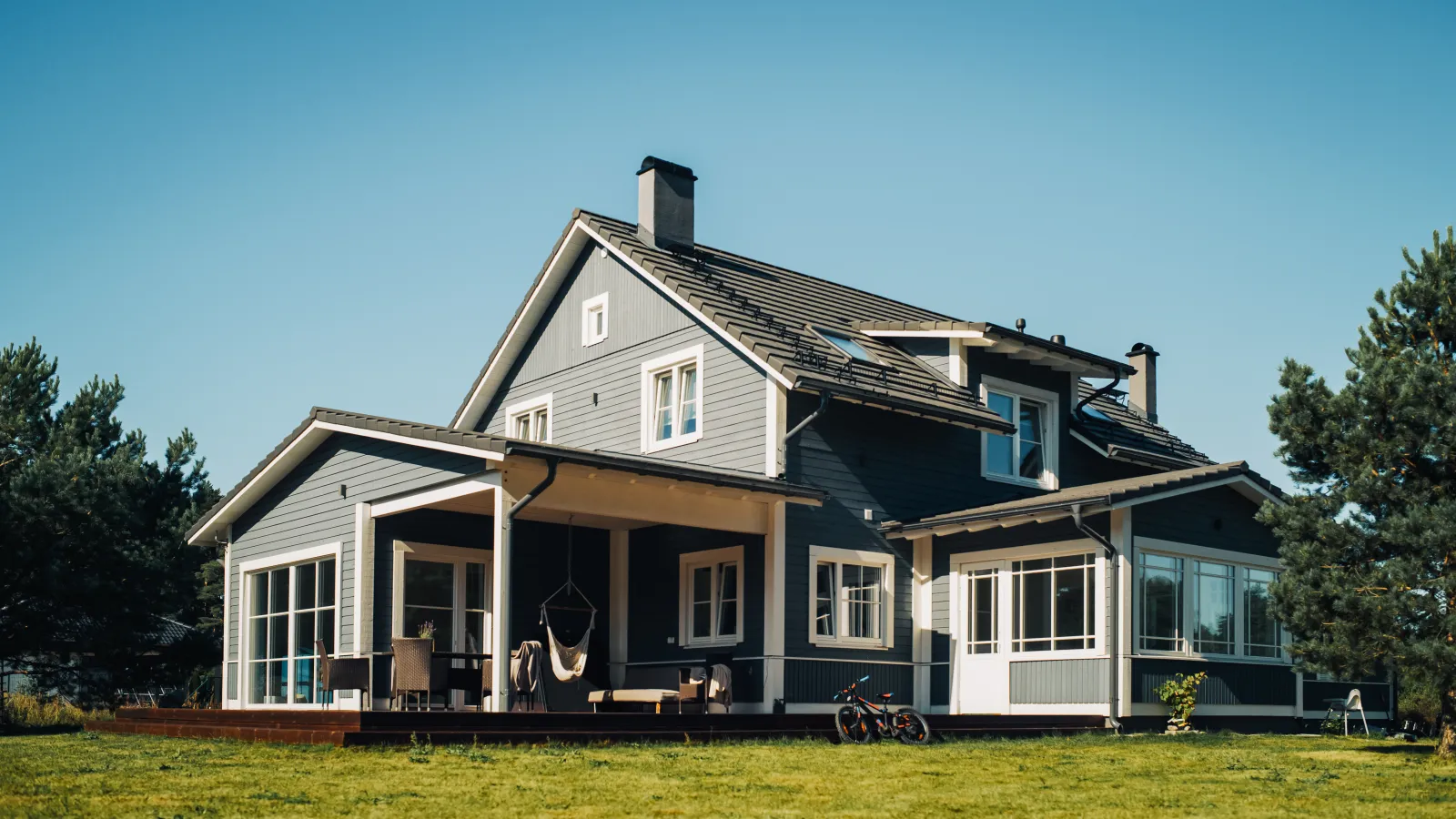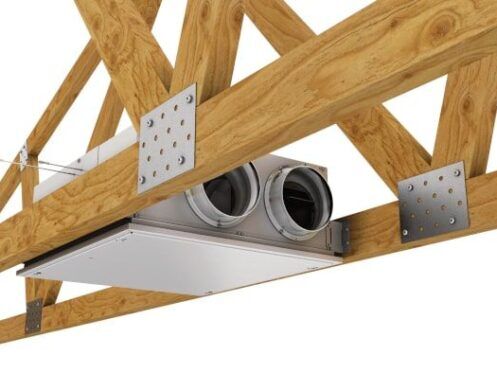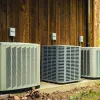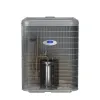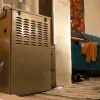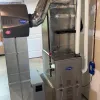Every home needs ventilation, but how should your home be getting it? And since you already know your home’s “natural” ventilation may not result in better air quality, what kind of equipment (if any) should you use to both ventilate and ensure the air you’re breathing is clean?
Two of the most popular options both end in “v.” One is an energy recovery ventilator or ERV. The other is a heat recovery ventilator or HRV.
If you’re looking for a quick answer to the ERV vs HRV question, there isn’t one. The choice of one over the other depends on four main factors:
- Local climate
- Size of the home
- Number of occupants
- Leakiness of the building envelope
By “leakiness,” we’re referring to air leaks. These are the gaps and cracks throughout the home where outdoor air can infiltrate the living space. Since these factors vary wildly from home to home, there’s no surefire way to say one way or another whether you need an HRV or an ERV.
Unless you happen to live in the South.
In hot, humid climates like the one we live in, you’re never going to want an HRV. An ERV makes way more sense here.
Here in Atlanta, we’d never recommend an HRV. An ERV is always the better choice. Let’s discover why that is, paying special attention to what’s unique about each of these ventilation devices. We’ll also explore alternatives to both ERVs and HRVs, so you can walk away from this article with a good sense of how best to ventilate your home.
Why bother ventilating at all?
Because the air circulating throughout your home likely contains contaminants. From household chemicals to off-gassing products to airborne allergens, our homes trap and confine potentially harmful airborne pollutants. And we’re always breathing them in.
Let’s not forget that many household activities also generate moisture: cooking and showering are the big ones. This moisture can raise the relative humidity (RH) of your indoor air, leading to issues with mold, dust mites, and damaging condensation.
Even when you intuitively know that fresh air ventilation is a good thing, the idea of installing a piece of equipment just to move some air around may seem… odd. It’s not. In many homes, mechanical ventilation isn’t merely helpful – although it is helpful for all homes – it’s actually necessary.
Why install special ventilation equipment?
Many newer, high-performance homes are very tightly sealed. They don’t have many air leaks, which is a good thing since it helps keep conditioned air in and unconditioned air out. But the lack of air leaks means these homes need a mechanical ventilation system. You’ve got to have an ERV, HRV, or some other device that moves fresh air into the home.
Of course, most people don’t live in high-performance homes. They might think that they don’t need ventilation equipment since their homes “ventilate” on their own due to air leaks.
But air leaks aren’t a source of ventilation. They’re a source of infiltration.
And air infiltration causes all sorts of problems:
- It’s unfiltered, so contaminants like pollen, vehicle exhaust, dust, and even airborne fiberglass particles from your insulation may circulate throughout indoor air.
- Humid air infiltrates your home for most of the year, making you feel uncomfortable.
- Due to the stack effect, the air that’s “ventilating” your home could be coming from the most unsavory of places: your attic (think dust and insulation) and crawlspace (think mold and insect dross).
Even opening windows can lead to indoor air quality problems, especially during the spring and summer when environmental allergens and moisture are in the air. Ventilation systems, such as HRVs and ERVs, filter the incoming air while ensuring the air you use for ventilation doesn’t come from your attic or crawlspace. In the case of the ERV (and we’ll explore this shortly), the system’s components may also reduce relative humidity (RH) levels indoors.
The bottom line? Tightly sealed, high-performance homes need mechanical ventilation. Many other homes should have it.
How much ventilation should your home get?
There’s actually a standard for that: ASHRAE 62.2.
The standard specifies that homes of certain square footage and a certain number of bedrooms need a certain amount of ventilation. For example, according to ASHRAE 62.2, a three-bedroom, 2,000 square-foot home requires an air exchange of 60 CFM (cubic feet per minute). You’d need some kind of ventilation system that moves air at a rate of 60 CFM all the time.
The ASHRAE standard doesn’t say how you should get this much ventilation. It just says that you need it. You could comply with ASHRAE 62.2 by using a simple bath fan that’s always on!
But exhaust-only fans aren’t a good way to ventilate.
What’s wrong with an exhaust fan?
Remember all the indoor air pollutants we discussed above? Well, a simple fan, such as the one you have in your bathroom, can bring more of that stuff into your home!
All of the air that leaves your home is replaced by air from the outdoors.
And it’s replaced in an equal amount. When you run a bath fan or kitchen fan, you may be exhausting moisture and odors from your home, but you’re also pulling in unfiltered outdoor air, complete with moisture, pollen, industrial pollutants, and so on.
Exhaust-only ventilation puts the home under negative pressure. The air is removed and needs to be replaced by “new” air. When the new air comes in, it’s entering the home via air leaks, not a closed system that filters the air and, in the case of an ERV, reduces moisture levels.
What do HRVs and ERVs have in common?
So far, we’ve established three things:
- Your home needs ventilation.
- Compared to reliance on air leaks (infiltration), ventilation systems provide fresher, cleaner air.
- Bath fans and other exhaust-only ventilation devices increase the infiltration of airborne contaminants.
Enter the HRV and the ERV. These systems provide balanced ventilation, which means they bring in just as much air as they remove. Whenever an HRV or an ERV is on, it’s expelling a given amount of air from the home and pushing the same amount of air into the home, directly from the outdoors. Oh, and each system filters the incoming air.
Neither an ERV nor an HRV puts the home under negative pressure or positive pressure. That’s why we call them “balanced” systems.
In each system, two air streams never mix. The outgoing air moves through one duct and the incoming air moves through a different duct. The system always moves and takes in the same amount of air it pushes out unless your contractor deliberately configures the ERV or HRV to positively pressurize the home. We’ll discuss positive pressure ventilation in greater depth toward the end of this article.
There’s something else that both ERVs and HRVs have that a simple “fan + filter” system doesn’t: an interior core.
An HRV transfers heat from one air stream to another.
Although the outgoing and incoming air never mixes, an HRV’s air ducts do pass through a central box. This box is a heat exchanger. Thermal energy from one air stream is transferred to the other air stream via conduction.
This process may seem simple, and it is. But it’s why an HRV is so much more than two fans and a filter.
Imagine you live in a cold climate. You want to ventilate your house, but the air outside is cold! A more direct form of ventilation (opening a window, say) would force you to run your furnace more often and make you feel less comfortable.
With an HRV, you can ventilate and transfer heat from the warm, outgoing air to the cold, incoming air. It’s why we call the HRV a “heat recovery” ventilation system. The device recovers some of the heat from your home and adds it to the incoming air stream.
This works nicely in summer, too. The heat from the hot incoming air is transferred to the cooler outgoing air. That way, the air being pushed into your home isn’t as hot as the air outside. An informational guide (PDF) from Aprilaire, which manufactures HRVs and ERVs, likens the process to mixing one cup of hot water with one cup of cold water to make one cup of warm water.
An ERV goes the extra mile by transferring moisture as well as heat.
Do you live in a humid climate? We do. Here in Atlanta, the humidity can be just as oppressive as the heat! When you ventilate your home, you don’t want the incoming air to be laden with humidity – you want it to be drier than the air outside.
An ERV can help here. Like the HRV, it contains a heat exchanger that transfers heat from one air stream to another. Unlike the HRV, the ERV also moves moisture between the two air streams.
The less humid air stream absorbs moisture from the more humid air stream, even though the air itself never actually mixes! This is possible because the ERV’s heat exchanger is made from a special membrane (a type of paper, typically) that allows moisture to migrate from one air stream to another.
An ERV won’t dehumidify your home. But it will ensure the air entering your home contains less moisture than the outdoor air.
By comparison, your other ventilation options – air leaks, exhaust fans, and even an HRV – bring all of that moisture into your home. The ERV doesn’t remove moisture like a dehumidifier, but it does reduce the amount of moisture inside the fresh air you use for ventilation.
In humid climates like ours, moisture reduction is a major plus! That’s why an ERV is always your best bet.
Ok. So, an ERV makes sense in Georgia. But what about a colder climate? What about, say… Vermont?
If you live in a cold climate, either an HRV or an ERV might make sense.
Remember how we said that the size of the home, number of occupants, and relative tightness or leakiness of the home will impact your choice of ERV vs. HRV? Well, those issues are front and center in cold climates.
Imagine you live in Vermont. You have a small family, and you live in a large home built in the 80s. The house has a pretty leaky building envelope. And since your family is small, you don’t generate a whole lot of humidity from cooking or showering. During those cold, dry Vermont winters, you’ll want to retain as much moisture as possible inside your home.
An ERV would transfer some moisture to the incoming air, allowing you to recover some of it even as you ventilate. For you, an ERV makes more sense than an HRV.
But what about your neighbors with the smaller, recently renovated home? This family of five bought a thirty-seven-year-old house and sealed all the air leaks. In this busy household, there’s always somebody cooking or showering. And since the house is so airtight, that humidity has few escape routes.
For this family, an HRV makes more sense. This system will exhaust the humid air and bring in drier outdoor air, providing welcome relief to the home’s occupants.
What if you live in a different type of climate?
Certain parts of the West and Midwest don’t fall into an obvious “hot and humid” or “cold and dry” climate category. What then?
Well, in many of these places, either an HRV or an ERV can work.
To make a well-informed choice, consider how tight your home is and how many occupants are in it. Collectively, do you generate a lot of humidity? In mixed climates, the choice of an ERV or HRV may come down to whether you want to recover or expel moisture relative to the outdoor humidity level.
If you have trouble coming up with the best answer, it might be because there isn’t one! You can probably use an ERV or an HRV and enjoy great results.
Another option for humid climates: the ventilating whole-house dehumidifier
As discussed above, ERVs and HRVs deliver balanced ventilation, which is preferable to negative pressure ventilation. But what about positive pressure ventilation?
Well, if balanced ventilation is your best option, positive pressure ventilation is a very close second! Provided that the incoming air stream is filtered, of course.
With a negative pressure device, like a bath fan, there’s no way to control where the replacement air enters your home.
The air seeps in through gaps and cracks throughout the house, carrying contaminants with it. With a positive pressure device, you can control where the air comes in. Not only can the air be filtered – but you might also be able to remove moisture from it, too!
Here’s where a whole-house dehumidifier becomes your friend. Typically, the unit integrates with your HVAC system’s ductwork and removes moisture from the air that’s already inside your home. However, it’s also possible to connect an additional duct to the whole-house dehumidifier and run that duct outdoors. That way, the dehumidifier can pull in outdoor air, filter it, and dehumidify it before delivering the air to your living space.
In otherwise leaky homes, a ventilating whole-house dehumidifier may even be preferable to an ERV.
You get better humidity control than with the ERV alone. Plus, you enjoy the benefit of having filtered fresh air.
On balance (pun intended), an ERV is a better choice because it gives you more direct control over ventilation amounts and timing, plus it doesn’t rely on your HVAC system’s blower fan like many dehumidifiers installations. And in the event, a positive pressure system makes more sense for your home and your specific indoor air quality needs, an ERV can be adjusted to positively pressurize the home!
By default, the ERV provides balanced ventilation. However, with just a modest adjustment, it can be set to provide more CFM of air than it exhausts. It’s just versatile like that.
Always ventilate. But ventilate wisely.
By now, you should have a pretty good idea about whether you need an ERV, HRV, or something else entirely… something like a ventilating whole-house dehumidifier. The main things to remember are that:
- Ventilation improves air quality.
- Negative pressure or exhaust-only ventilation = not good.
- Mechanical ventilation systems improve air quality and comfort.
- HRVs and ERVs are similar but use an ERV in humid climates.
- Ventilating whole-house dehumidifiers are another good option for humid climates.
And if you live in metro Atlanta and want to discuss your options for ventilation and better air quality, please get in touch! We’ll listen to your concerns and help you find the best ventilation option for your needs and budget.
